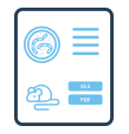If you’re applying or have received a research grant from the European Research Council (ERC), you have probably read this document on the criteria your research must fulfil in order for you to receive the financial aid for your research. This article uses the official ERC document guidelines to demonstrate why an Electronic Lab Notebook (ELN) will save you time and effort when complying with the ERC regulations, as ELNs are designed to aid scientists with data management.
In this blog we will cover:
The ERC is an institution which provides financial support to scientists conducting exceptional research. Like other institutions, it gives a grant to successful research teams who meet the ‘FAIR’ requirements. Since 2017, grantees must comply with the Horizon 2020 Open Research Data requirements. This means that all grantees must allow open access to data, if not, they must have a sufficient justification pertaining to why they do not allow open access. In order to demonstrate that ERC funded projects are compliant with the ‘FAIR’ regulations, grantees are required to submit a Data Management Plan (DMP) to provide evidence.
The ERC accentuates that: “writing a DMP should not be regarded as a purely administrative exercise. Rather it should provide a positive stimulus to thinking about how data generated within the project will be stored, managed and safeguard”.
In order to comply with the regulations, an individual or institution receiving the grant must have good data management principles integrated into the research from its inception.
ELNs provide a flexible unified platform where you can store all scientific data relating to a project. In this way ELNs can be used for more than just a record keeping system, they can be used to ensure that you and your research team are upholding good data management, which is a requirement of many grant funds. ELNs typically support use of all the different processes connected with experiments and research, so they can be used to ensure that you have fulfilled the ‘FAIR’ guidelines to your research needed for your data management plan.

Refers to how easy it is for people or computers to find your data or data related to your research.

Stored in a manner where it is openly available (with exceptions). The grantee must be able to explain where the data, associated metadata, documentation and code are deposited and how this can be accessed.

Data must be structured in a way where it can be combined with other data sets. Data must be described in a standard way, using accepted metadata standards.

How the researcher ensures that the data will remain reusable.The grantee must document the data licensed and what the quality assurance procedures are.

The ERC also labels some guidelines on the allocation of resources and data security. This refers to the procedures for data backup, recovery, transfer and storage of secure data to ensure long term preservation and curation.
The ERC emphasises that the DMP must have a “dynamic framework”, one which is flexible and can be modified as the research progresses. An ELN is a tool which is designed to aid and facilitate good data management. Adopting an ELN into your laboratory will give you more control over your data whilst also facilitating greater access to your data, saving you time.
The ERC document also states that it “recognises that data annotation and deposition are time consuming activities” it suggests that to solve this “ERC grant money can be specifically earmarked” either to contribute to the salary of an assistant or to cover the expense of a commercial provider.
You can achieve this through using the dataset description tool on an ELN. Using this tool you ensure that your dataset is always findable through using unique identifiers; this can be through identifying the authors of the project, materials used or the date of entry. You are able to quickly retrieve your data and metadata through providing one piece of information.
Labfolder offers two mechanisms to retrieve data: a filter in the Notebook view and an advanced search system that allows the combination of multiple search queries with logic gates. Within this, you can use an automatic unit conversion to find items of the same amount but have a different documented unit. This ensures that you can always find your experiments even with limited information whilst also allowing you to compare experiments that use the same amount of a certain inventory item.
Monitoring standards of data and metadata aids knowledge and discovery. This can be achieved through ensuring that people and computers can check all of the research. ELNs have become an invaluable tool in this area as they provide a platform where it is easy to structure your data and metadata in a way where you can link together different entries, data and inventory items or even authors.
Labfolder achieves the above, but also offers a number of alternatives to help you structure your data. With Labfolder you can add different content into a single entry using different elements such as text, images, tables, graphs, file uploads and sketches to allow you to shape your data entry in the way you want. Further to this, you can identify your data through using an entry header which shows you the author, unique id, entry title, timestamps and tags. You can use data elements to structure your data, organising your experimental parameters, which ensures that your data is coherently organised and labelled, in turn increasing reusability. Moreover, over the course of your research you are able to see inventory items at specific points, you can view the updated version of an inventory item, but also revert back to the original if required. Tags may also be used in this instance, to allow you to compare how materials were used in different situations, ensuring that you describe your data in a standardised way using the accepted measures.
When considering the licensing, note that ELNs enable admins to have complete control over which individuals can contribute content to specific projects. The admins can decide which users have the ability to see content, ensuring the right people have access to projects. An entry will always have the name of the author attached, allowing you to always be aware of who has made an entry. Data sets can be identified through the data description tools, allowing the author to note the inventory items used in the project ensuring that your data is findable and reusable.
Team collaboration is also an important element of this section, Labfolder’s advanced version allows you to create groups to help researchers orientate and organize people within a project. Once the groups are created you may find that you need subgroups for smaller internal projects. Labfolder allows you to set up subgroups, even allowing you to assign sub-admins, facilitating better team collaboration whilst at the same time ensuring that data is always correctly labelled under the author of a project or sub-project. Labfolder also offers a highly detailed material database (MDB) which can be customized to suit the individual. With this you can create as many MDBs as you want with as many items and categories listed as you require, ensuring that the dataset is always identifiable.
ELNs also have many built in functions to ensure that they are fulfilling security and integrity requirements. On an ELN entry creations and edits are all recorded along with the author, time and date of the action, this is called a “full audit trail” or “versioning”. This allows you to view and retrieve data or files from your history. This full audit trail is viewed alongside an entry and can enable a researcher to see the full history and if needed, determine whether an error was made. Security is a key element of online services and cloud computing, many ELNs have as a result implemented features to secure data in a safe environment.
With Labfolder you can also use the full audit training to revise any edits made on imported images, spreadsheets or documents, ensuring that you can always revert it back to the original. Original content which is uploaded by the user is never altered and can always be recovered with a 3-click process, ensuring integrity. Labfolder also offer the free “Sign and Witness” app which can be used if data or an entry needs to be signed and witnessed by other team members or supervisors in order to comply with ISO or FDA regulations. Further to this, an advanced version of the app “Signature Workflows” is available as a paid add on. It enables researchers to tailor the witnessing process to their own requirements, streamlining data compliance. Regarding security, Labfolder has implemented strong and reliable security infrastructures which provide maximum protection for your data whether it be based in the cloud or a local server ensuring that your data is always secure and available whenever you need it.
Using an ELN means that your data is in a digitalised format as soon as it is entered into your lab notebook. Through using the relevant software tools provided, you can store your data in a manner which is easily accessible on one platform. It acts as a central storage unit allowing you and your team to collaborate on projects, whilst ensuring that all of the data is openly available to those who you enable to view the project at the same time.
Labfolder addresses data sharing through enabling the researcher to export a number of different formats. This ensures that when required a researcher can easily access the data in an offline format of their choosing. Further to this, it is possible to share data within a team using the custom share settings enabling an individual using the Labfolder to share projects with specific team members or the entire team. Facilitating greater connectivity and data sharing amongst colleagues. Another feature of the Labfolder is that you have the ability to use the framework and layout and create a template from that for future use, this ensures that you can keep to regulations by following a previous model created. These templates can also be shared amongst colleagues, encouraging the whole team to have good data management and keep to the standard.
“A DMP which meets the requirements of these 5 sections will meet the FAIR principles”

The ERC article also lists some example data depositories they recommend to use when conducting research (e.g. Zenodo, Dryad, Figshare etc.). Some are supported by ELNs, Labfolder for example uses Figshare as an additional app which can be used alongside the ELN.
Whether you have received an ERC grant or are thinking of applying, good data management practices should always be a key consideration at the start of any project. ELNs are a tool which are designed to help researchers maximise their time by enabling them to manage their data efficiently. They are a central platform where all research can be stored and properly identified, ensuring data is Findable, Accessible, Interoperable and Reusable, the requirements for the ERC grant.
For more information go to the ERC website.
If you are interested in trying out an ELN, Labfolder has a free version available that you can use to determine whether it is the right ELN for you!
Leave a Reply